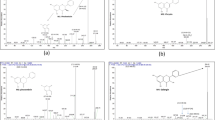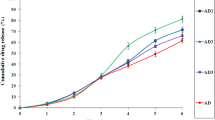Abstract
The objective of this study was to prepare and evaluate the pectin-based dosage form for buccal adhesion. Carbenoxolone sodium, which is used for the treatment of aphthous ulcers in oral cavity, was used as a model drug. The pectin buccal discs were prepared by direct compression. The water uptake and erosion of pectin disc increased progressively with the swelling time. The bioadhesion of dried pectin discs decreased when either the discs were hydrated or the buccal tissue was wet with a small volume of medium. The influencing factors such as pectin type, pectin to lactose ratio, and sweetener type on the formulations were investigated. The results demonstrated that buccal discs prepared from pectin with a high degree of esterification (DE) showed a weaker and more friable characteristic than that with low DE. Decreasing pectin to lactose ratio resulted in the high dissolution rate with low bioadhesive properties. Addition of sweetener in the formulations also affected the hardness, friability, and bioadhesive properties of the discs. The pectin discs containing sweetening agent showed a higher drug release than those without sweetener. The results suggested that pectin-based bioadhesive discs could be used to deliver carbenoxolone sodium in oral cavity.






Similar content being viewed by others
References
Mcbride DR. Management of aphthous ulcers. Am Fam Physician. 2000;62:149–60.
Bruce A, Rogers R. Acute oral ulcers. Dermatol Clin. 2003;21:1–15.
Burgress JA, Johnson BD, Sommers E. Pharmacological management of recurrent oral mucosal ulceration. Drugs. 1990;39:54–65.
Jongviriyaphun N, Kanawong N. Effects of carbenoxolone sodium spray on viral-induced oral mucosal ulcers and aphthous ulcers. Thai J Pediatr. 1996;35:135–43.
Turpie AG, Thomson TJ. Carbenoxolone sodium in the treatment of gastric ulcer with special reference to side-effects. Gut. 1965;6:591–4.
Partridge M, Poswillo DE. Topical carbenoxolone sodium in the management of Herpes simplex infection. Br J Oral Surg. 1984;22:138–44.
Miyazaki S, Kawasaki N, Nakamura T, Iwatsu M, Hayashi T, Hou WM et al. Oral mucosal bioadhesive tablets of pectin and HPMC: in vitro and in vivo evaluation. Int J Pharm. 2000;204:127–32.
Senel S, Ikinci G, Kas S, Yousefi-Rad A, Sargon MF, Hincal AA. Chitosan films and hydrogels of chlorhexidine gluconate for oral mucosal delivery. Int J Pharm. 2000;193:197–203.
Sungthongjeen S, Sriamornsak P, Pitaksuteepong T, Somsiri A, Puttipipatkhachorn S. Effect of degree of esterification of pectin and calcium amount on drug release from pectin-based matrix tablets. AAPS PharmSciTech. 2004;5:E9.
Sriamornsak P, Thirawong N, Puttipipatkhachorn S. Emulsion gel beads of calcium pectinate capable of floating on the gastric fluid: effect of some additives, hardening agent or coating on release behavior of metronidazole. Eur J Pharm Sci. 2004;24:363–73.
Sriamornsak P, Sungthongjeen S, Puttipipatkhachorn S. Use of pectin as a carrier for intragastric floating drug delivery: carbonate salt contained beads. Carbohydr Polym. 2007;67:436–45.
Sriamornsak P, Thirawong N, Weerapol Y, Nunthanid J, Sungthongjeen S. Swelling and erosion of pectin matrix tablets and their impact on drug release behavior. Eur J Pharm Biopharm. 2007;67:211–9.
Rolin C. Pectin. In: Whistler RL, Bemiller JN, editors. Industrial gums: polysaccharides and their derivatives. New York: Academic; 1993. p. 257–93.
Schmidgall J, Hensel A. Bioadhesive properties of polygalacturonides against colonic epithelial membranes. Int J Pharm. 2002;30:217–25.
Liu L, Fishman ML, Hicks KB, Kende M. Interaction of various pectin formulations with porcine colonic tissues. Biomaterials. 2005;26:5907–16.
Thirawong N, Kennedy RA, Sriamornsak P. Viscometric study of pectin–mucin interaction and its mucoadhesive bond strength. Carbohydr Polym. 2008;71:171–9.
Thirawong N, Nunthanid J, Puttipipatkhachorn S, Sriamornsak P. Mucoadhesive properties of various pectins on gastrointestinal mucosa: an in-vitro evaluation using texture analyzer. Eur J Pharm Biopharm. 2007;67:132–40.
Sriamornsak P, Wattanakorn N. Rheological synergy in aqueous mixtures of pectin and mucin. Carbohydr Polym. 2008;74:474–81.
Sriamornsak P, Wattanakorn N, Nunthanid J, Puttipipatkhachorn S. Mucoadhesion of pectin as evidence by wettability and chain interpenetration. Carbohydr Polym. 2008;74:458–67.
Takeda C, Takahashi Y, Seto I, Kawano G, Takayama K, Onishi H et al. Influence of pectins on preparation characteristics of lactoferrin bioadhesive tablets. Chem Pharm Bull. 2007;55:1164–8.
Mashru R, Sutariya V, Sankalia M, Sankalia J. Transbuccal delivery of lamotrigine across porcine buccal mucosa: in vitro determination of routes of buccal transport. J Pharm Pharmaceut Sci. 2005;8:54–62.
Turner D. Water sorption of poly(methyl methacrylate): 1. Effects of molecular weight. Polymer. 1987;28:293–6.
Malucelli G, Sangermano M, Bongiovanni R, Priola A, Keddie JL. Water sorption in polymer network films synthesized from PEO oligomers containing acrylic and vinyl ether functionalities. Polym Bull. 2000;45:431–8.
Mortazavi SA, Smart JD. An investigation into the role of water movement and mucus gel dehydration in mucoadhesion. J Control Release. 1993;25:197–203.
Gurny R, Meyer JM, Peppas NA. Bioadhesive intraoral release systems: design, testing and analysis. Biomaterials. 1984;5:336–40.
Sanzgiri YD, Topp EM, Benedetti L, Stella VJ. Evaluation of mucoadhesive properties of hyaluronic acid benzyl esters. Int J Pharm. 1994;107:91–7.
Shojaei AH, Paulson J, Honary S. Evaluation of poly(acrylic acid-co-ethylhexyl acrylate) films for mucoadhesive transbuccal drug delivery: factors affecting then force of mucoadhesion. J Control Release. 2000;67:223–32.
Kim H, Venkatesh G, Fassihi R. Compactibility characterization of granular pectin for tableting operation using a compaction simulator. Int J Pharm. 1998;161:149–59.
Sungthongjeen S, Pitaksuteepong T, Somsiri A, Sriamornsak P. Studies on pectins as potential controlled-release matrix tablets. Drug Dev Ind Pharm. 1999;25:1271–6.
Acknowledgments
The authors wish to acknowledge the Commission of Higher Education, Thailand, and the Thailand Research Fund (TRF) for the financial support (grant number RMU4880042). NW is supported by a postdoctoral research grant from the Commission of Higher Education, Thailand. We are very pleased to acknowledge Herbstreith & Fox KG (Germany) who kindly donated the pectin samples and N. Kanawong (Paholpolphayuhasena Hospital, Thailand) who kindly supplied carbenoxolone sodium. Thanks to K. Wannalak for assistance on sample preparation.
Author information
Authors and Affiliations
Corresponding author
Rights and permissions
About this article
Cite this article
Wattanakorn, N., Asavapichayont, P., Nunthanid, J. et al. Pectin-Based Bioadhesive Delivery of Carbenoxolone Sodium for Aphthous Ulcers in Oral Cavity. AAPS PharmSciTech 11, 743–751 (2010). https://doi.org/10.1208/s12249-010-9424-x
Received:
Accepted:
Published:
Issue Date:
DOI: https://doi.org/10.1208/s12249-010-9424-x




